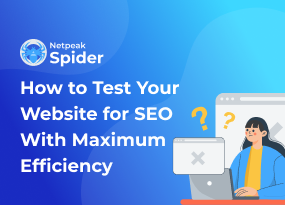30 Go-To Questions for Potential SEO Clients [with SEO Marketing Brief Template]
How to![30 Go-To Questions for Potential SEO Clients [with SEO Marketing Brief Template]](https://static.netpeaksoftware.com/media/en/image/blog/post/97989078/900x300/brief-for-seo-clients.jpeg)
To have a clear vision of the future project and make sure you’re on the same page with your client, you should ask proper questions. It will help you get a touch of the project, a potential client, products, services, and prepare for work before everything is set in stone.
- 1. Information about the Client
- 2. Website Description
- 3. Website Content
- 4. Keyword Research
- 5. Other Marketing Verticals
- SEO Marketing Brief Template
1. Information about the Client
From the outset, specify:
- What the company does – the products / services the client provides and the same products / services presented on the market.
- Services / products – a brand name and description of the products and / or services, price range, other peculiarities.
- Contact persons – it’s super important to know the people you’re going to work directly with and whom you can address in case of any question or further clarification.
1.1. Details about Company’s Activity
After researching the general information, get down to more specific questions. Some of them could make the client raise the eyebrows, but insists on your right to understand what’s going on with their current setup.
Investigate these questions:
- How long is your business presented on the market?
- Do you plan to go offline? If you already have any brick-and-mortar business: offices, production, showrooms, etc. specify them.
- What number of orders have been processed to this day?
- Describe your sales funnel.
- Do you have any special discounts / offers? Do you fix up any sales campaigns (Black Friday)?
- How do you interact with the customer? Describe the customer journey.
- Who is your ideal customer?
- What problems do your customers face that make them pick your competitor instead?
- What are the FAQs about your company? What answers do you usually give?
- Do you have any remarkably processed orders that you feel proud of? Give an example of the ‘known’ clients you have.
1.2. Competitive Edge
Do a little digging into your client’s USP (unique selling proposition), their bright sides, competitive edge over other market players, which makes them outstanding in your customers' eyes.
Such upsides may be:
- Company’s age
- Licensing
- Short production terms (for instance, 3 days)
- Eco-friendliness of the materials
- Certificates
- Official representatives
- Delivery / installation / deinstallation / service
- Individual approach
- Cutdown prices (let’s say, they have direct supplies from factories that guarantee low price)
- Hasty delivery
- Straightforward payment process
- Warranty (for instance, 5 years)
- Discount system for loyal customers
- A broad array of products
- Rich color spectrum
- Quality (10 certificates of quality are living proof of that)
- Consulting service (for free)
- Seasoned experts
1.3. Project Goals
Knowing the company’s main goals and KPIs will give you insights into what you need to get to bring them where they want to be
Better yet, you can get a holistic picture of how doable these goals are for the current setup.
So these are the informational goals the company may want to achieve:
- To briefly inform visitors about the company’s scope of activities and services / products provided.
- To walk the visitor through the detailed individual research of the products / services the company provides.
- To build brand awareness (build it, strengthen, or alter).
- Promote the company / product / service / brand.
- Enlightening goals.
- To get feedback (product counseling, demo requests, reading the guidelines, etc.).
Here are some commercial goals:
- The attraction of final customers.
- The attraction of new partners / dealers.
- Provision of services.
- Order / booking placement.
- Purchases.
- Retention of existing dealers and partners.
1.4. Competitors in the Given Field
To develop a nitty-gritty SEO strategy, you’ll need to get to know the industry in general. Make your clients talk about competitors on their radar, their strengths, and their weaknesses.
It’s better seen when given in the table.

1.5. Partners in the Given Field
Does your client have any relationships with other businesses and entities? Find it out since it’s a lucrative link-building opportunity that could have gone missing for years.
It may look like this:

1.6. Achievements: Certificates, Awards, etc.
If the client doesn’t have a developed USP yet or can’t clearly articulate the business strengths, you may want to ask about existing certificates and awards. Make it clear that all this information can contribute to trust and authority rates.
1.7. Targeting Countries
Make sure you’re on the same page with the client’s goals on targeting geolocation. If needed, specify that targeting exact locations will help come up with a more effective SEO strategy.
If the client’s goal is to reach a broader audience, specify whether the website is designed for multilingual SEO.
1.8. SEO Background
Ask if any SEO operations had been conducted on the website before. If so, get more details on:
- The list of the works that had been carried out (optimization of content, metadata, etc.).
- The time that took to conduct that work including stopovers.
- If the links were purchased in bulk.
- What SEO agency led SEO works.
- Any SEO-related documents – keyword research, the last performance reports and metrics, strategy briefs, etc.
2. Website Description
To know the real numbers and state of affairs, ask the following:
- The CMS on which the website is built – it’s good to know in advance how friendly CMS is and what problems can occur with the backend side of things.
- Access to the website CMS, Google Search Console, Google Analytics – ask to gain access to these tools as soon as possible.
- Access to website hosting (or access to FTP).
3. Website Content
Get access to the website ‘brand book’ and media assets (images, videos, audios, texts, etc). The information given to these questions may be handy from SEO bent when you get started working on the project:
- Do you have unique content for the website?
If needed, explain: for your website to rank in search engines, it should contain unique content. If you want to borrow a text from another website, it should be rewritten (rewrite helps to increase the uniqueness of the text).
- Do you have quality author photos for the website? (for design, for content filling)
- Do you have videos for the website?
Find out about what content on other websites seems fetching to your client. The things like narrative style, tone of voice, the subjects they touch upon, how the content is displayed on the page, the type of content that prevails on the website – images, videos, graphs, plain text, etc.
Getting that kind of information, you’ll be able to visualize the desired end goal even if the client’s vision is vague at this stage.

4. Keyword Research
Knowing the search queries that are supposed to run the project could give you some insights into their current priority.
So ask your client what keywords are supposed to promote the website.
If your client hadn’t gotten his hands dirty with SEO before, follow up with further specifications:
- What products, services, premises, stores, cafes, hotels, etc. are you going to promote with ties to geolocation? (‘Thai food delivery Queens New York’).
- List the keywords that require specific intentions (buy, order, doors installation).
Write all the keywords into the table and ask a client to sort them out according to priority, taking into account the company's hallmarks. Mark with:
- High priority
- Standard priority
- Low priority
5. Other Marketing Verticals
Ask if a company is committing to display ads and social media advertising. Ideally, you also ask how much they invest in it just to know if other marketing vertices work well and bring tangible results.
The Bottom Line
As an aspiring SEO specialist, you can face different reactions to your initial research of the company. Sadly enough, not nearly every company can provide clear answers to your questions. To clear up the mess, don’t shy away from asking as much as you can, follow up, ask for more details to see what is an undercurrent. Fishing for information that will alleviate your work – this should be your priority.
And to crown it all, grab this ready-made template, tailor it to your needs, and send directly to your clients.



